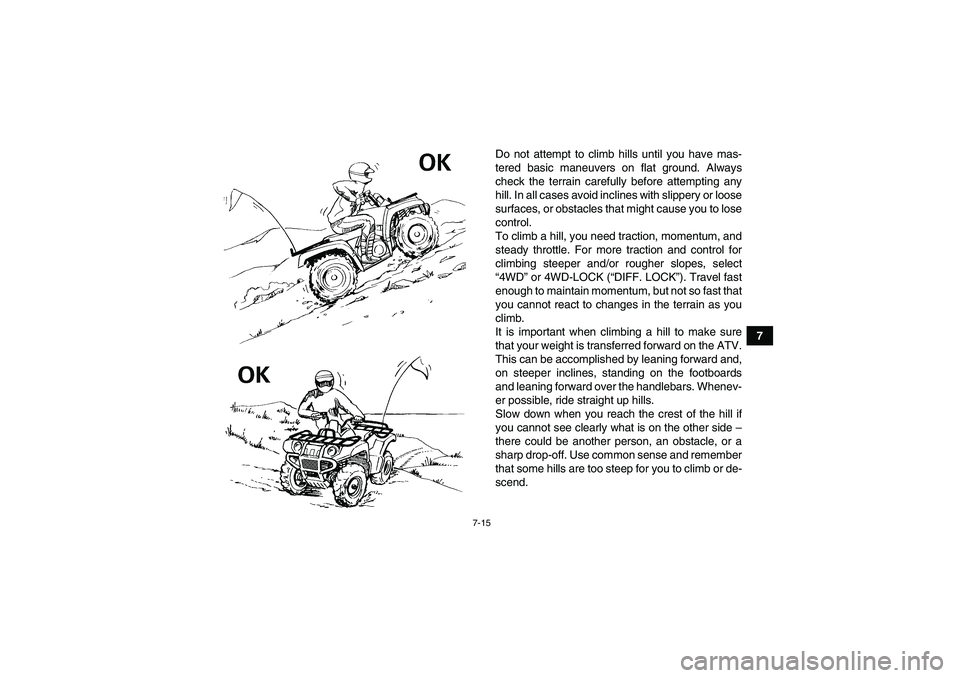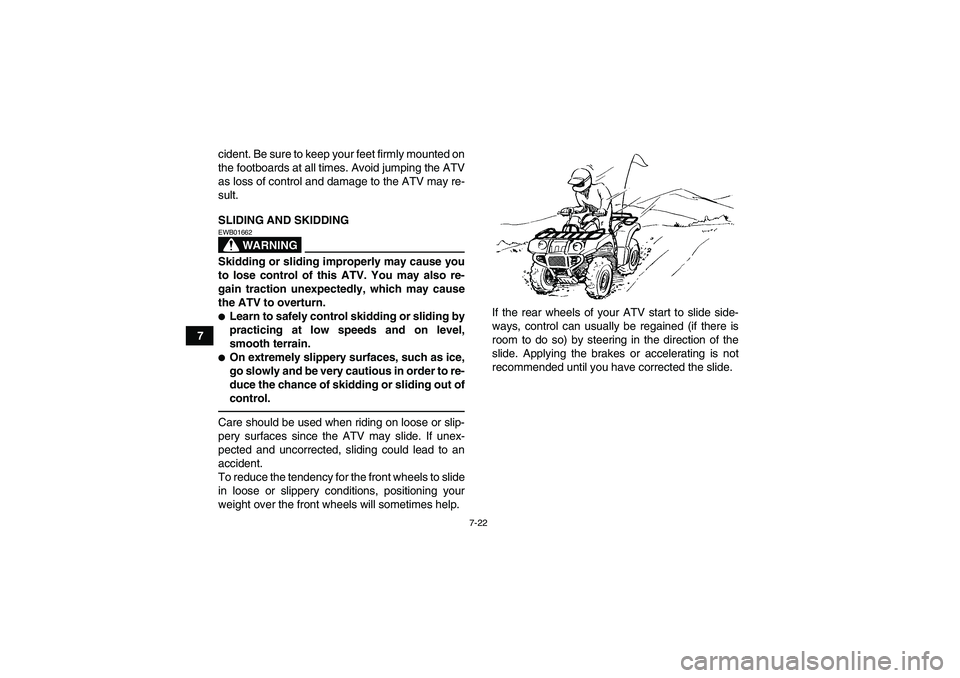Page 77 of 168
7-11
7 Do not operate on rough, slippery, or loose terrain
until you have learned and practiced the skills nec-
essary to control the ATV on such terrain. Always
be especially cautious on these kinds of terrain.
WARNING! Failure to use extra care when op-
erating on excessively rough, slippery, or
loose terrain could cause loss of traction or
ATV control, which could result in an accident,
including an overturn.
[EWB01541]
When riding in an area where you might not easily
be seen, such as desert terrain, mount a caution
flag on the ATV. DO NOT use the flag pole bracket
as a trailer hitch. WARNING! You could collide
with another vehicle if operating in areas where
you cannot easily be seen. Mount a caution
flag on the ATV to make you more visible.
Watch carefully for other vehicles.
[EWB01551]
U43P62E0.book Page 11 Tuesday, February 17, 2009 1:09 PM
Page 78 of 168

7-12
7Do not ride in areas posted “no trespassing”.
Do not ride on private property without getting per-
mission.
Select a large, flat, unpaved area to become famil-
iar with your ATV. Make sure that this area is free
of obstacles and other riders. You should practice
control of the throttle, brakes, shifting procedures,
and turning techniques in this area before trying
more difficult terrain.
Shift to the park position and follow the instruction
on page 6-1 to start the engine. Once it has
warmed up you are ready to begin riding your ATV.
With the engine idling, shift the drive select lever
into the low-range position or the high-range posi-
tion. Apply the throttle slowly and smoothly.The centrifugal clutch will engage and you will start
to accelerate. If the throttle is applied too abruptly,
the front wheels may lift off the ground, resulting in
a loss of directional control. Avoid higher speeds
until you are thoroughly familiar with the operation
of your ATV.
When slowing down or stopping, release the throt-
tle and apply the brakes smoothly and evenly. Im-
proper use of the brakes can cause the tires to lose
traction, reducing control and increasing the possi-
bility of an accident.
NOTICEECB00251Do not shift from low-range to high-range or
vice versa without coming to a complete stop.
Damage to the engine or drive train may occur.TURNING YOUR ATV
WARNING
EWB01771Always follow proper procedures for turning
as described in this Owner’s Manual. Practice
turning at low speeds before attempting to turn
U43P62E0.book Page 12 Tuesday, February 17, 2009 1:09 PM
Page 79 of 168

7-13
7 at faster speeds. Do not turn at speeds too fast
for your skills or the conditions. ATV could go
out of control, causing a collision or overturn.
To achieve maximum traction on unpaved surfac-
es, the two rear wheels turn together at the same
speed. Therefore, unless the wheel on the inside
of the turn is allowed to slip or lose some traction,
the ATV will resist turning. A special turning tech-
nique must be used to allow the ATV to make turns
quickly and easily. It is essential that this skill be
learned first at low speed.
As you approach a curve, slow down and begin to
turn the handlebars in the desired direction. As you
do so, put your weight on the footboard to the out-
side of the turn (opposite your desired direction)
and lean your upper body into the turn. Use the
throttle to maintain an even speed through the turn.
This maneuver will let the wheel on the inside of
the turn slip slightly, allowing the ATV to make the
turn properly.This procedure should be practiced at slow speed
many times in a large unpaved area with no obsta-
cles. If an incorrect technique is used, your ATV
may continue to go straight. If the ATV doesn’t
turn, come to a stop and then practice the proce-
dure again. If the riding surface is slippery or loose,
it may help to position more of your weight over the
front wheels by moving forward on the seat.
Once you have learned this technique, you should
be able to perform it at higher speeds or in tighter
curves.
1. Lean towards inside of turn.
2. Support your weight on the outer footboard.
U43P62E0.book Page 13 Tuesday, February 17, 2009 1:09 PM
Page 81 of 168

7-15
7 Do not attempt to climb hills until you have mas-
tered basic maneuvers on flat ground. Always
check the terrain carefully before attempting any
hill. In all cases avoid inclines with slippery or loose
surfaces, or obstacles that might cause you to lose
control.
To climb a hill, you need traction, momentum, and
steady throttle. For more traction and control for
climbing steeper and/or rougher slopes, select
“4WD” or 4WD-LOCK (“DIFF. LOCK”). Travel fast
enough to maintain momentum, but not so fast that
you cannot react to changes in the terrain as you
climb.
It is important when climbing a hill to make sure
that your weight is transferred forward on the ATV.
This can be accomplished by leaning forward and,
on steeper inclines, standing on the footboards
and leaning forward over the handlebars. Whenev-
er possible, ride straight up hills.
Slow down when you reach the crest of the hill if
you cannot see clearly what is on the other side –
there could be another person, an obstacle, or a
sharp drop-off. Use common sense and remember
that some hills are too steep for you to climb or de-
scend.
U43P62E0.book Page 15 Tuesday, February 17, 2009 1:09 PM
Page 88 of 168

7-22
7cident. Be sure to keep your feet firmly mounted on
the footboards at all times. Avoid jumping the ATV
as loss of control and damage to the ATV may re-
sult.
SLIDING AND SKIDDING
WARNING
EWB01662Skidding or sliding improperly may cause you
to lose control of this ATV. You may also re-
gain traction unexpectedly, which may cause
the ATV to overturn.�Learn to safely control skidding or sliding by
practicing at low speeds and on level,
smooth terrain.�On extremely slippery surfaces, such as ice,
go slowly and be very cautious in order to re-
duce the chance of skidding or sliding out of
control.Care should be used when riding on loose or slip-
pery surfaces since the ATV may slide. If unex-
pected and uncorrected, sliding could lead to an
accident.
To reduce the tendency for the front wheels to slide
in loose or slippery conditions, positioning your
weight over the front wheels will sometimes help.If the rear wheels of your ATV start to slide side-
ways, control can usually be regained (if there is
room to do so) by steering in the direction of the
slide. Applying the brakes or accelerating is not
recommended until you have corrected the slide.U43P62E0.book Page 22 Tuesday, February 17, 2009 1:09 PM